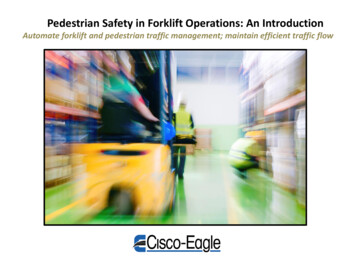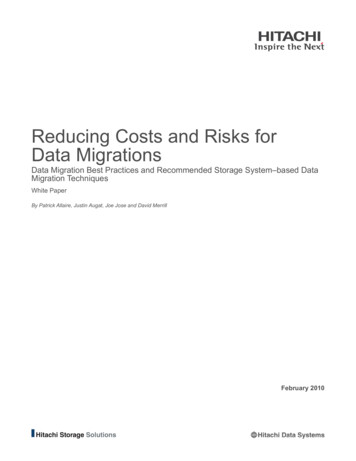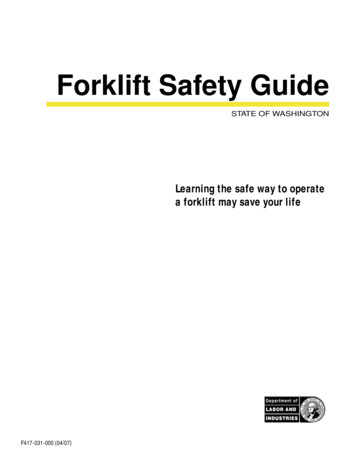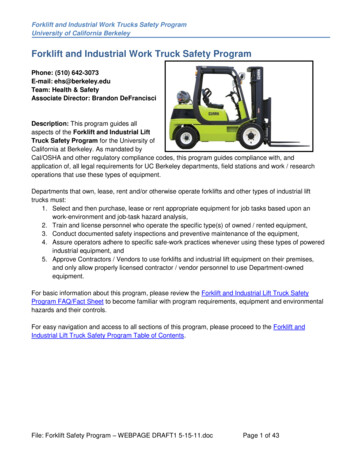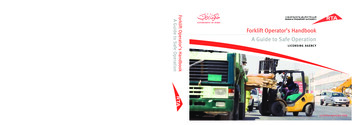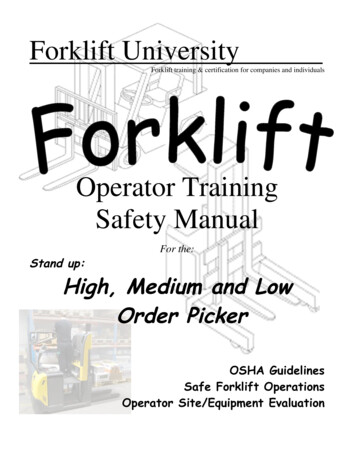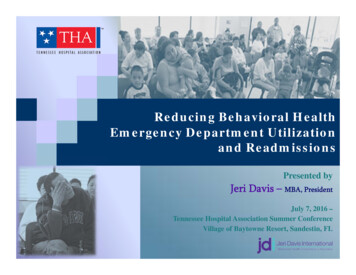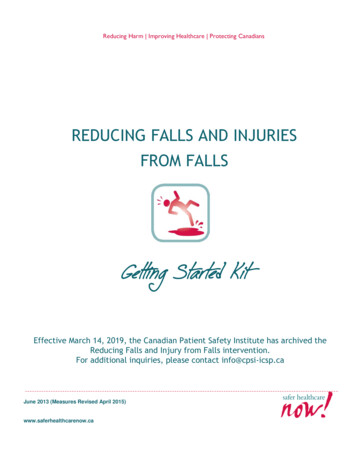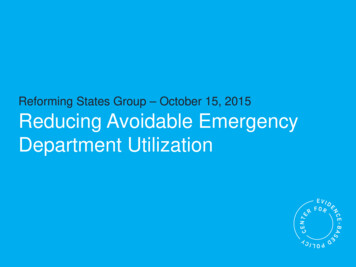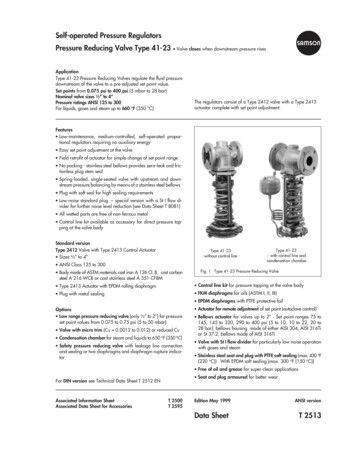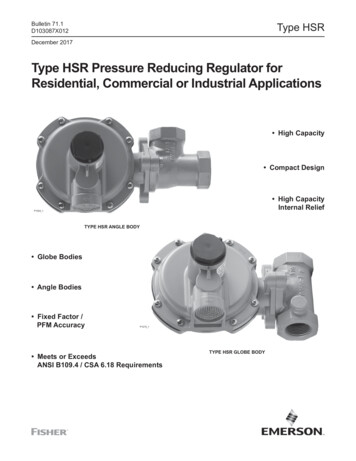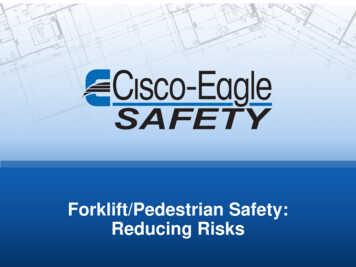
Transcription
Forklift/Pedestrian Safety:Reducing Riskswww.cisco-eagle.com/safety
WelcomeCisco-Eagle is a national and international material handling systems integration company with customers in all 50 states andover 70 nations. We have broad experience in safety systems design and implementation.5 years ago we created a division focused solely on the design and manufacturing of safety products, with an emphasis onforklift safety.2www.cisco-eagle.com/safety
About MeI started with Cisco-Eagle in 2016, and work with our safety products divisionI frequently attend PPSA, ASSE and NSC show. You can find my articles on forklift/pedestriansafety on the Cisco-Eagle blog.3www.cisco-eagle.com/safety
Session Objectives1. Understand the threat forklifts pose to pedestrians2. Create a facility-wide forklift/pedestrian process4www.cisco-eagle.com/safety
Why Is This Process Important?5www.cisco-eagle.com/safety
Pedestrians in perilOf the accident types listed above,46% involve a pedestrian—someone other than the forklift driver.6www.cisco-eagle.com/safety
Why Is This Process Important?Forklifts aren’t cars The average car weighs roughly 3,000 pounds, while the average forkliftweighs 9,000 pounds Forklifts don’t maneuver or brake as well as cars. They have worse line ofsight for the driver. Forklift drivers are often moving in reverse or have loads raised Dangers are constant Pedestrians misunderstand the way forklifts maneuver, and thedanger of walking or working around them.7www.cisco-eagle.com/safety
Why Is This Process Important?Formula fortragedy: Pedestrian not paying attentionDriver has forks up, so visibility is lowSafety gate would help keep the pedestrian from coming into contactSight lines obstructed by rack against the wallWarehouse egress points concern8www.cisco-eagle.com/safety
Process StepsStep 1: Assemble a cross-functional forklift safetyteamStep 2: Develop a baseline assessmentStep 3: Identify forklift/pedestrian interaction zonesStep 4: Assess risks at each interaction zoneStep 5: Implement safety upgradesStep 6: Measure your progress9www.cisco-eagle.com/safety
Step 1:Assemble A Cross-FunctionalForklift Safety Teamwww.cisco-eagle.com/safety
Create A Cross-Functional Forklift Safety TeamThis team should lead the processInclude a manageable number of employees, and draw a diverse team: Forklift Operations Supervisors and Foremen Safety & EHS Personnel Warehouse Employees Shipping/Receiving Order PickingEach member represents a diversity of opinion, and can help the safetydepartment make better decisions11www.cisco-eagle.com/safety
Create A Cross-Functional Forklift Safety TeamResponsibilities include: Helping with baseline analysis Conducting risk assessments of high traffic areas Creating actionable solutions12www.cisco-eagle.com/safety
Step 2:Develop a BaselineAssessmentwww.cisco-eagle.com/safety
Developing A Baseline AssessmentDocument the current conditions: Include these factors: Cross functional information to determine facility-wide issues Assets you have at your disposal Current condition (what processes or behaviors currently exist) What exists now that segregates vehicles from pedestrians Audio/visual control systems? On-board controls on forklifts? What are the current behaviors for drivers/pedestrians?14www.cisco-eagle.com/safety
Developing A Baseline Assessment – Sample Survey15www.cisco-eagle.com/safety
Developing A Baseline AssessmentFocus on the following factors: Elimination: In this scenario, an area is set up for foot traffic only. Forkliftsare not allowed at all. These areas should be delineatedwith guardrails or other physical barriers. You can also employpainted or taped crosswalks or other visual methods to markthese zones when necessary.16www.cisco-eagle.com/safety
Developing A Baseline AssessmentFocus on the following factors (continued): Reduce forklifts with alternative pallet handling methods: Identify areas where foot traffic is constant, forklift traffic is notdesirable, but pallet movement is necessary. You might handlepallets with stackers, pallet jacks, conveyors, pallet dollies17www.cisco-eagle.com/safety
Developing A Baseline AssessmentFocus on the following factors (continued): Barriers & physical controls: Are physical controls such as guard rails, bollards, curbs, gatesystems or other solid separation means present? Can they beinstalled to improve the situation?18www.cisco-eagle.com/safety
Developing A Baseline AssessmentFocus on the following factors (continued): Visual Warning Systems: Protective systems like sensors, mirrors, signs, warning lights,or proximity detection technologies. Score your facility on thepresence or absence of these warning systems.19www.cisco-eagle.com/safety
Developing A Baseline AssessmentFocus on the following factors(continued): Training/Processes: What’s currently in place in terms oftraining, rules, and processes thatimpact forklift safety? (Example:require dedicated crossing points, orexclusion zones). Are workers allowedto use smart phones in the facility? Arethey paying attention to the pathways?How are egress points into the facilityhandled? How are guests and visitorsprotected?20www.cisco-eagle.com/safety
Step 3:Define Interactions forForklifts and Pedestrianswww.cisco-eagle.com/safety
Define “Interactions” For Forklifts and PedestriansIt’s critical to understand where your pedestrians and forklifts interact.When you create a safety plan, segregate people from forklifts as much aspossible, and then focus on interaction zones where separation isn’tpossible.22www.cisco-eagle.com/safety
Why Is This Process Important?Separation of forklift and pedestrian aisles helpscreate a safer space Reduces the amount of interactions between workers and trucks Lowers the risk of injury Creates a safer work environment for workers and visitors23www.cisco-eagle.com/safety
Define Interactions For Forklifts and Pedestrians24www.cisco-eagle.com/safety
Define Interactions For Forklifts and Pedestrians Print a drawing of your facility and map these interactions Create a color-coded visual representation of pedestrian traffic aisles andthen use a different color to represent forklift areas In the example above, pedestrian areas are yellow, forklift lanes aregreen, and interaction zones are red dots The points where pedestrians and forklifts intersect are your interactionzones Mark and number these interaction zones. Create a list of these zones Address the needs of each zone.25www.cisco-eagle.com/safety
Step 4:Assess the Risk Factors inEach Interaction Zonewww.cisco-eagle.com/safety
Assess The Risk Levels In Each Interaction Zone Once you’ve identified the at-risk areas, you should rate each of them(feel free to use your own assessment system). This risk assessment willhelp you prioritize each intersection or crossing and suggest a course ofaction to reduce the risks in that zone. The assessment should include the following factors: Accident probability: How close will forklifts and pedestrians get toeach other? How tight is the area? What speed are the forkliftstraveling? Is visibility adequate for safe operations? Are pedestrianspaying attention to their surroundings? Are drivers honking hornsand actively looking for pedestrians?27www.cisco-eagle.com/safety
Implement Safety Upgrades Traffic levels at the interaction point: How often do people passthrough or work in the area? How frequently do forklifts run through?Is it infrequent, constant, or somewhere in between? Frequency of pedestrian/forklift conflict: Count the number oftimes per day that forklifts and pedestrians intersect, or are bothpresent in an area that lacks guardrails or other physical barriers.This does not have to be direct contact. It can be the simplepresence of both types of traffic in an area where an accident ispossibleOnce you have profiled each interaction zone, it’s time to address thatparticular point, with a plan and priority.28www.cisco-eagle.com/safety
Step 5:Implement SafetyUpgradeswww.cisco-eagle.com/safety
Implement Safety UpgradesTime to build a solution. These solutions can vary from zone to zone, basedon the factors in your assessment. If that’s not possible, move towardsolutions that address the area’s safety concern. These may include: Whenever possible, create exclusion zones where people andforklifts aren’t allowed to mingle. Decide whether the zone can bechanged into an exclusion zone, where there is no interaction betweenpeople and forklifts. You will want to create as many exclusion zones aspossible, since they are the safest alternative. For instance, many companies build pallet rack systems with cartonpicking on the floor level and bulk pallet storage in higher bays. Thisis an efficient way to use space, and it does create a full aisle wherepeople and lift trucks frequently share space. This may change plantlayout and routes a bit, but the safety gains tend to justify it.30www.cisco-eagle.com/safety
Implement Safety Upgrades Implement hard barrier controls, such as guardrails, bollards orgates. These should be used to create areas where people are physicallyseparated from lift truck traffic. Increase visibility, with methods like floor striping, signage, forkliftwarning lights, mirrors or paint lines. These are relatively passivemethods, but they are necessary to help reinforce expected behavior andmake people aware of the potential dangers. Consider gates or straps toclose aisles. Make it a process: administrative controls, such as training, processimprovements and new policies Consider automation: Automated controls, such as warning sensors,automated gates, backup sensors, onboard speed controls, cameras andother methods for managing forklifts & pedestrians31www.cisco-eagle.com/safety
Step 6:Measure Your Progresswww.cisco-eagle.com/safety
Measure your progress To gauge the effectiveness of implemented changes in the way peopleand forklifts interact, we recommend that you periodically: Update your assessment guide Re-assess the interaction areas to see if further changes should bemade Revisit the process as facility and personnel changes occur33www.cisco-eagle.com/safety
Resources A Step-by-Step Safety Process for Forklifts and Pedestrians Cisco-Eagle Safety Blog Reducing the Risk of Injury Between Forklifts and Workers Why the Floor is Better than Eye Level for Forklift SafetyWarnings34www.cisco-eagle.com/safety
agle.com/safety
Questions?www.cisco-eagle.com/safety
Create A Cross- Functional Forklift Safety Team. This team should lead the process. Include a manageable number of employees, and draw a diverse team: Forklift File Size: 2MBPage Count: 36
